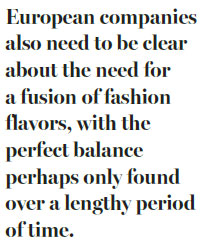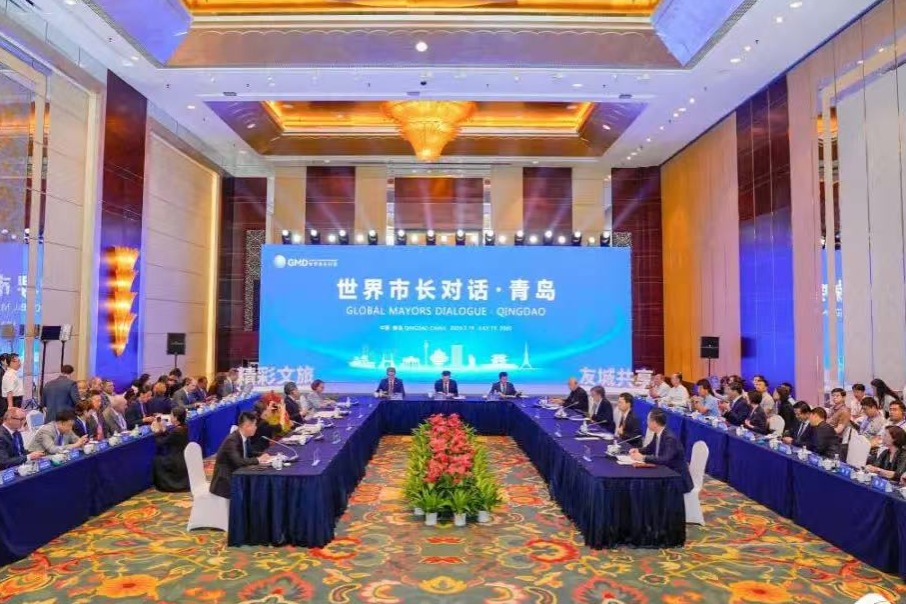Top Western brands face fading appeal

Chinese luxury consumers do not automatically attach significant emotional value to even famous, successful and prestigious labels
Professional daigou - overseas-based shoppers who buy luxury brands on behalf of Chinese mainland consumers such as designer clothes, cosmetics, jewelry and watches - account for approximately 12 percent of total Chinese luxury goods spending, which equates to a staggering $5 billion.
But the figure, despite being impressive, has been falling in the last few years. While many attribute this decrease to the Chinese government tightening import controls as well as introducing a raft of policies designed to stimulate domestic spending, the rapid increase in competitiveness and attractiveness of Chinese luxury brands is perhaps the main reason.

My research over the past few years has consistently revealed a subtle but significant change in Chinese consumers' attitudes toward luxury goods, both established Western brands and Chinese brands.
It is this intangible change that Western brands, and the European luxury sector in particular, needs to understand more clearly and its marketing implications.
The tangible raising of import taxes on postal items and on luxury goods brought by daigou returning to China by air, as well as the whopping 100 percent increase in the tariff on luxury watches to a sizeable 60 percent, have had significant impact.
Access to certain overseas websites, where luxury brands can be both browsed and bought, in certain free trade zones such as Shanghai has also contributed to a decline in the daigou industry.
But what appears to have been overlooked is the change in Chinese consumers' perception of established, Western luxury brands and their fading emotional appeal.

In March 2015, French luxury brand Chanel announced an immediate 20 percent reduction in price on the Chinese mainland, presented as part of a global pricing realignment. Such a dramatic move was soon followed by other luxury brand heavyweights such as Cartier and TAG Heuer.
But the mistake made by many then, and now, is that economics and rational consumer decision-making explained these price cuts. For example, the relative weakness of the euro as that time was cited by many as a major causal factor.
While such tangible factors no doubt play a part, it is the intangible and emotional issues associated with luxury brands in the minds of Chinese consumers that by far play the most important part.
Many argue that the daigou industry has flourished due to the prevalence of fake luxury goods on the Chinese mainland and that overseas shopping is perhaps the only way of ensuring genuine goods. Of course, this has played a pivotal part in daigou activity but there has also been, until very recently, enormous emotional attachment that Chinese consumers have formed with a luxury brand bought in a major, fashionable European city such as Paris or London.
For example, a Burberry trenchcoat bought in a fashionable outlet in the heart of London's prestigious shopping areas infinitely carries more emotional meaning than compared with the very same item purchased in a Chinese shopping center.
Brand association and brand attachment, where Chinese consumers are concerned, is much more than, and goes far deeper than, any prestigious brand name and logo and other aspects of public presentation. The country of origin, or COO, effect plays a large part in any Chinese consumer's construction of brand meaning, especially where luxury and luxury fashion brands are concerned.
Until recently the major fashion cities of Europe, London and Paris and Milan in particular, and their respective country images have perhaps held an exclusive and certainly impregnable hold on any positive COO effect. This effect, and perhaps changes in the balance of power, should be the focus of attention for European luxury brands.
But this is now changing, and change could be exponential.
Chinese consumers, particularly of luxury goods and luxury fashion, do not now automatically attach significant emotional value to even the most famous, successful and prestigious Western brands such as Louis Vuitton and Gucci. No longer is it the case that Paris and France, and Milan and Italy conjure up a construction of considerable emotional meaning in the minds of the typical Chinese consumer. This is why the daigou's days are indeed numbered.
Chinese consumers, particularly the younger generation, are now driven by more modern values such as "independence" and even "rebelliousness", far more than traditional Confucian values such as "belonging" and "moderation". This goes some way to explaining a decline in the appeal of accepted, established European luxury fashion brands.
But, fascinatingly, the same Chinese consumers appear to have retained a strong sense of tradition and values such as "nostalgia" and "tradition" with an increase in modern values.
The daigou industry has also been challenged by the increasing competitiveness and attractiveness of Chinese luxury fashion brands.
Brands such as Shanghai Tang, Belle and Xander Zhou are representative of a far more professional brand building and management approach now taking place in Chinese luxury fashion brand producers.
Counter-intuitively, it appears that younger Chinese consumers value traditional Chinese elements in clothing and branded goods far more than older generations.
So, how should European luxury fashion brand producers respond to this fundamental change in Chinese consumer values and consequent change in attitude and perception toward the world's "top" brands?

Lesson one has hopefully been learned, albeit the hard way, by Chanel. Such a sizeable and immediate price reduction represents a major faux pas.
Chinese consumers' retention of traditional values does not stretch to "frugality" and the more modern value of "hedonism" more often than not manifests itself in the form of "elitism". Any price slash, therefore, will be met quizzically by Chinese consumers.
But with "nostalgia" and an acute appreciation of traditional Chinese culture appearing to influence luxury fashion brand consumption, it behoves the European luxury fashion industry to step back, rethink and reposition their brand offerings with the incorporation of Chinese elements in mind.
Such a change in brand positioning also needs to go further than any cosmetic change and perhaps include elements of traditional Chinese designs and patterns and color combinations as well as shapes.
European companies also need to be clear about the need for a fusion of fashion flavors, with the perfect balance perhaps only found over a lengthy period of time.
Chinese luxury consumers, especially the more heavy-spending younger generations, value traditional Chinese elements but only within a "modern" context which probably requires the retention of key aspects of any brand's established heritage.
The daigou industry, therefore, in its present form is on an irreversibly downward path. But with a more complex building of luxury fashion brands now taking place among Chinese consumers, it is perhaps the daigou who are best placed to advise European luxury brand heavyweights about much needed brand repositioning in China
The author is a visiting professor at the University of International Business and Economics in Beijing and a senior lecturer at Southampton University. The views do not necessarily reflect those of China Daily.
(China Daily European Weekly 08/18/2017 page12)
Today's Top News
- Mayors from around the world gather in Qingdao for dialogue
- Premier announces construction of Yarlung Zangbo hydropower project
- Digital countryside fueling reverse urbanization
- 'Sky Eye' helps unlock mysteries of the universe
- China offers LAC development dividend
- Future sectors to receive more play






























